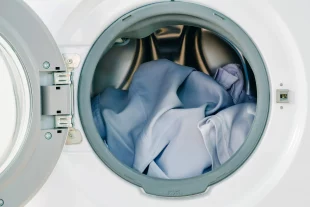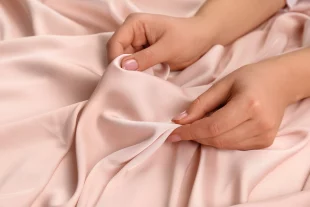 Get How-To's
Get How-To's
How to Iron
👗New Service Alert – Quinceanera Dress Preservation!
Read tips, tricks, and how-to’s on our Fabric of Life blog.
How-To's

When it comes to doing laundry, separating your clothes properly may seem like an extra step, but it’s one that can make a world of difference. Separating laundry preserves the quality, color, and longevity of your clothes. Mixing fabrics and colors in one wash can lead to color transfer, fabric damage, and wear and tear that shortens the life of your clothes. Following a few simple guidelines can ensure your clothes stay in top condition, wash after wash.
The most important step in the laundry process is the sorting process. When you sort your laundry correctly, you’re not only protecting your clothes but also ensuring they’re cleaned thoroughly and safely. Here’s a breakdown of the best ways to separate laundry:
The classic rule is to separate white clothes from dark or bright colors. Dark fabrics tend to bleed color during the wash cycle, and mixing them with lighter fabrics can lead to unwanted color transfer.
Items like socks, cotton shirts, and bedsheets go into the “whites” pile.
Jeans, black T-shirts, and other darker fabrics go into the dark pile to avoid staining your lighter clothes.
For bold pieces of clothing, like that red sweater or yellow pants, separate from both whites and darks, as they’re prone to bleeding during their first few washes.
Different fabrics play a role in how you should wash your clothes. Mixing heavy towels with delicate fabrics like silk blouses or dress shirts can lead to damage. To avoid this, group your laundry based on fabric type and use appropriate washing cycles and water temperatures.
Items like bath towels, jeans, and jackets can handle more agitation and typically benefit from a longer cycle with warm or hot water. The heat helps break down dirt and oils, especially in thicker fabrics.
Fabrics like lace, silk, or chiffon should be set aside and washed on a delicate cycle or hand-washed. When you’re sorting your laundry, set aside any delicate fabric items and use the delicate cycle on your washing machine, or opt for a hand wash. This cycle uses less agitation and cooler water to prevent damage.
Athletic clothing often contains elastic materials like spandex, which can break down in high heat. Wash these items in cold water on a gentle cycle to preserve elasticity and color. Avoid using fabric softeners, as they can block the fabric’s moisture-wicking properties.
You don’t want to wash your dirty clothes that are stained with mud or oil with lightly worn items. Heavily soiled clothes need more intense cleaning, and washing them with cleaner items can spread dirt and stain particles.
Don’t forget to check the care label on each garment to ensure you’re using the right water temperature and cycle for each fabric. Not sure how to read laundry symbols? Check out our article that breaks each down.
At the end of the sorting process, you should ideally have four distinct piles:
The correct temperature ensures your laundry gets thoroughly cleaned without damaging your clothes.
Ideal for delicate items, bright colors, and lightly soiled clothing. It helps prevent color transfer and is gentler on fabrics like silk and wool. Cold water is also more energy-efficient, saving both your clothes and your power bill.
Great for synthetic fabrics like polyester and nylon, warm water helps clean dirty laundry without shrinking or damaging your clothes. It’s a balanced option for most fabric types.
Best for heavier items like bath towels, bedsheets, and heavily soiled items. Hot water helps to disinfect clothes and remove tough stains but should be avoided with delicate or brightly colored fabrics to prevent damage or fading.
Delicate fabrics and items with stains require special attention. Here are a few tips to keep your clothes in the best condition:
Pre-treat stains with a stain remover before washing to help break down the particles. Stain particles can spread during the wash if not treated properly, leading to discoloration in other clothes. For delicate fabrics, be sure to use a gentle stain remover and cold water for spot treatment.
For particularly delicate items like lace or embellished clothing, hand washing is the safest method. Fill a basin with cold water and mild laundry detergent, and gently swish the fabric to clean it without stretching or distorting the fibers.
By taking these extra steps, you can ensure your delicate items and heavily stained dirty clothes remain in great condition.
Separating your laundry into the correct categories of color, fabric type, and soil level not only protects your clothes from damage but also extends their life. By selecting the proper wash cycle, water temperature, and laundry detergent, you’ll get clean clothes that look and feel fresh every time.
For those times when you want to make laundry day easier, CD One Price Cleaners offers expert services that ensure your clothes are treated with the utmost care. Whether you need help with large loads or specialty fabrics, our team is here to provide you with the best results, ensuring your clothes come back spotless, fresh, and in perfect condition.
Ready to take the hassle out of laundry? Find a CD One Price Cleaners near you and let us help extend the life of your wardrobe with professional cleaning services tailored to your needs.
We think you may like
 Get How-To's
Get How-To's
How to Iron
 Get How-To's
Get How-To's
How to Wash Silk
 Get Garment Guides
Get Garment Guides
The Ultimate Guide to Delicates